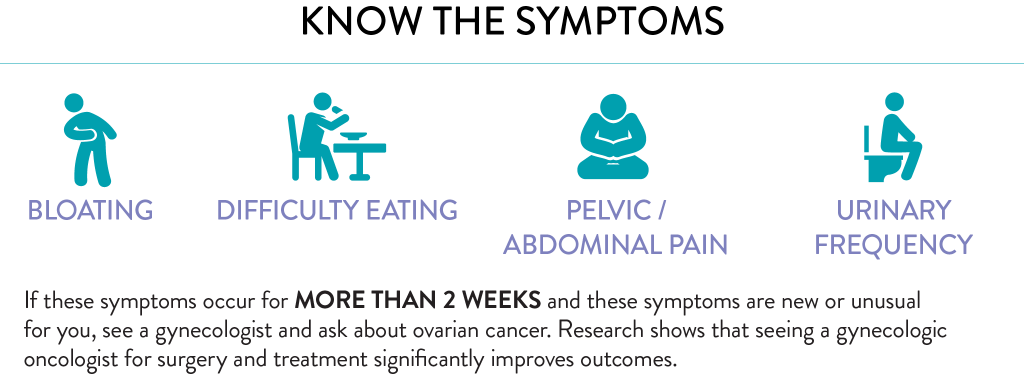What is Ovarian Cancer?
Cancer is a disease in which some of the body’s cells begin to divide without stopping, and spread into surrounding tissue. Ovarian cancers are a group of diseases that affect the ovaries.
The ovary is made up of three types of cells. Epithelial cells cover the surface of the ovary. Cancers originating from these cells are the most common type of ovarian cancer, called epithelial ovarian cancer. Because these epithelial cells also line the fallopian tubes and form the peritoneal membrane which encases organs in the abdomen and pelvis, epithelial cancers can also arise from these sites. Tubal cancers and primary peritoneal cancers are treated the same way as epithelial ovarian cancers, and often the term EOC is used to include all three sites of origin.
The other cell types in the ovary are germ cells, also called oocytes or egg cells, and stromal cells, which produce hormones. Cancers arising from germ cells or stromal cells are considered distinct tumor types, and may be treated differently than epithelial ovarian cancers, as described below.
What are the different types of ovarian cancer?
Ovarian cancers are now known to be several distinct diseases, classified according to the cells from which they arise, and further grouped by pathological factors such as how they appear under a microscope, and their behaviors.
- Epithelial ovarian cancers, which arise from the surface of the ovary (the epithelium), are the most common ovarian cancers. Fallopian tube cancer and primary peritoneal cancer are also included within this designation.
- Germ cell ovarian cancers arise from the reproductive cells of the ovaries, and are rare.
- Stromal cell ovarian cancers, which arise from connective tissue cells, is very rare.
- Small cell carcinomas (SCCO) of the ovary are an extremely rare ovarian cancer subtype and it is not certain whether the cells in SCCO are from ovarian epithelial cells, sex-cord stromal cells or germ cells.
Are all ovarian tumors cancerous?
Not all ovarian tumors are cancer. Ovarian tumors can be benign (noncancerous) or malignant (cancerous). Cells of benign tumors do not spread to other parts of the body (metastasize).
Additionally, ovarian cysts are different from ovarian tumors, and can be fairly common—ovarian cysts are fluid-filled while ovarian tumors are solid masses. Most ovarian cysts are not harmful, don’t cause symptoms and are not indicative of risk for future ovarian cancer, though some complex ovarian cysts may raise the risk.
Common Symptoms of Ovarian Cancer
In many cases, ovarian cancer does not produce noticeable symptoms until the disease is in advanced stages. Symptoms associated with ovarian cancer can sometimes be mistaken for other common problems. Those with ovarian cancer most commonly report these symptoms:
- Bloating
- Pelvic or abdominal pain
- Difficulty eating or feeling full quickly
- Urinary symptoms (urgency or frequency)
Less Common Symptoms Associated with Ovarian Cancer
Though the following symptoms have been reported by those diagnosed with ovarian cancer, they are less useful in helping to identify the disease because of their frequency in the general population:
- Fatigue
- Indigestion
- Back pain
- Pain with intercourse
- Constipation
- Menstrual irregularities

While it is important to know the symptoms of ovarian cancer, as it may lead to quicker diagnosis, studies show that symptom recognition alone is not useful in detecting the disease early, and earlier diagnosis may not alter the disease course or outcome. As we continue to strive for a cure, learn how genetic testing can help identify those at high risk, and options for prevention.
Ovarian Cancer Detection and Diagnosis
There is no screening or early detection test for ovarian cancer. The Pap test does not test for ovarian cancer; it is only a reliable screening tool for cervical cancer. If a doctor suspects ovarian cancer, they may perform a combination of preliminary tests including a pelvic exam, radiological tests that may include a transvaginal ultrasound or CT scan, and a CA-125 blood test. Doctors may also use these tests to monitor those with a strong family history of ovarian or breast cancer, or a known genetic mutation such as a BRCA mutation.
Ovarian cancer can only be definitively diagnosed through a surgical biopsy. This surgery should always be performed by a gynecologic oncologist, as research shows that those whose surgeries are performed by gynecologic oncologists experience better outcomes.

